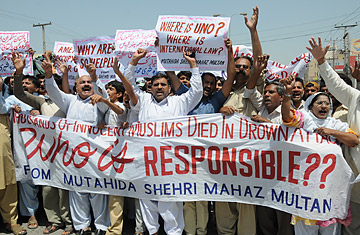
Pakistani protesters demonstrate to condemn U. S. drone attacks in Pakistani territory on Friday, April 22, 2011 in Multan, Pakistan.
For the past six weeks, Pakistan has echoed with ferocious opposition to the CIA's covert drones program that targets al-Qaeda and Taliban militants hiding in the tribal areas along the Afghan border. Ever since Pakistan's army chief General Ashfaq Parvez Kayani issued a rare and fiercely worded condemnation of a March 17 drone strike, his criticism of the U.S. has been repeated by the prime minister, opposition politicians, and media commentators alike. And in that time, the CIA has fired only two drone more strikes, breaking a pattern of around a dozen a month.
The latest drone strike happened on Friday, on the heels of U.S. Chairman of the Joint Chiefs, Admiral Mike Mullen and U.S. Army Chief Gen. Martin Dempsey's visits to Pakistan. Top American and Pakistani military, intelligence and government officials have been trying to calm the tensions between the allies through meetings in Washington and Islamabad. But little progress has been made: Prime Minister Yousaf Raza Gilani continues to call for the drones to stop, as Friday's strike killed 25 people, including four women and five children, according to Pakistani officials. The reasons for Pakistan's sudden decision to end seven years of either tolerating or silently approving of the drones program remain unclear, raising questions about the nature of its current vehement complaint.
In fact, the ambiguity of the situation arises from the ranks of the Pakistani military — out of the public arena. For example, on March 23rd, Gen. Kayani played host to a clutch of senior retired generals and, amid the tea and collegial bonhomie, the conversation casually turned to Kayani's statement a week earlier. Some of the visitors wondered why he had adopted such a sharp tone, describing the March 17 attack as an "unjustified and intolerable" violation of human rights. "These drones do have some use," one of the retired generals said, according to someone present. "Yes, they do have a use," Gen. Kayani was heard to reply.
Ever since the advent of the CIA program, the Pakistani security establishment has been content to at least tolerate the covert drones, and even come to discreetly approve of it. The very first drone strike in 2004 killed Nek Muhammad, a forerunner to the Pakistani Taliban. In 2006, when an airstrike killed some 80 people in Bajaur, provoking domestic outrage and the first major retaliatory suicide bombing, Pakistan maintained that its forces were responsible for the incident — not the U.S. And, over at least the past year, Pakistani generals have come to be impressed by the accuracy of the drones and their ability to limit militant movements.
One general had even gone public with his approval. In early March, before the strike that stirred up the controversy, Maj. Gen. Ghayur Mehmood, the general officer commanding Pakistan's seventh division in North Waziristan, told reporters: "Myths and rumors about U.S. predator strikes and the casualty figures are many, but it's a reality that many of those killed in these strikes are hardcore elements, a sizeable number of them foreigners." According to the general's own figures, 164 predator strikes had killed over 964 terrorists over the past four years. The results have won the drone program some supporters in the tribal areas; the loudest protests emanate from areas well removed, like Punjab.
Drones have always been a delicate and difficult issue for the U.S. and Pakistan. The benefits to Washington are obvious — a pilotless means of warfare that allows high-value targets to be eliminated in a territory where it cannot deploy troops. In recent years, the CIA has developed its own, impressive network of local assets that pinpoint targets; meanwhile, enhanced drone technology with smaller, sleeker missiles has meant fewer civilian casualties. For the Pakistanis, the use of technology that surpasses their own has been welcome, where the targets have been of mutual interest — members of al-Qaeda and the Pakistani Taliban.
